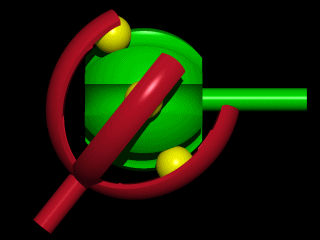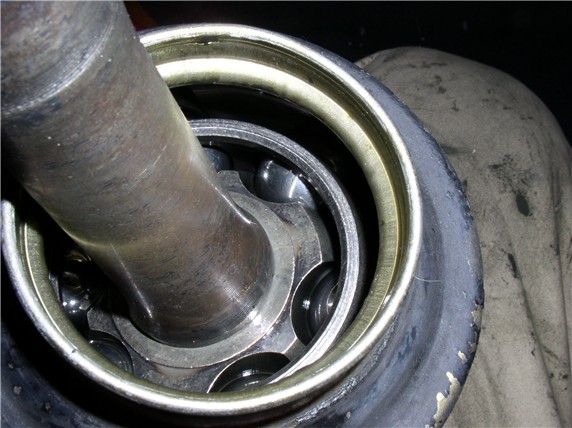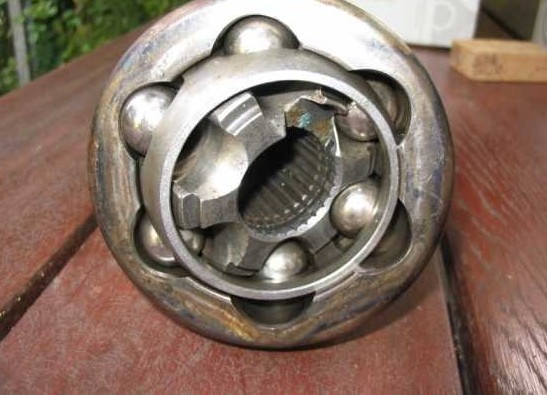

Gents,
I've been replacing the boots on the cv joints on my 78 5spd and have
spent all afternoon on one axle. I kept the ball bearings matched up
with the cv collar that they came out of but now that the shaft is
completely reassembled, I've got almost zero cv type movement. Both
ends wiggled nicely before I started but not anymore. I've got the
groove of the collar correct (outside ends of shaft), fresh grease,
fresh boots, no movement. What gives? Is there a secret dance I have
to do before they'll show me some movement?
TIA
Mike LaBranche
84 S, blk/blk, AT, 112k
78 OB, silver/tan, 5spd, 50k
=========
Hahahahahahahaha,
I did the same thing. I was bitching and moaning because I had such a hard time
getting it all back on the car. Turned out I didn't look at the picture in the
book close enough. You need to match the narrow spacing on the hub with the wide
spacing on the shell.
DOH!
Like putting the distributor gear spacer back on wrong... Right Doc?
jfk
=========
Hello, Mike!
The usual problem is turning the center piece around the wrong way.
Wally Plumley
928 Specialists
========
yes there is a secret........ CV joints can be put together wrong after they
fall apart and the ball bearings roll around on the floor . If you look at the
star the center it has big points and small points the outer ring has big flats
and small ones . The small points inner must line up with the big flats outer .
The wrong way they will self destruct .
Jim Bailey
928 International
Jim@928intl.com
=========
I'm stumped on how to assemble the inner CV joint properly on my '85 928S.
While I was doing a brake & clutch hydraulic flush, I noticed that that the left
outboard CV joint boot was torn, so I decided to drive no more until I replaced
it. In fact I decided to do all four and have no worries for a good loooooooong
time.
I wiped out the outer joints as much as possible and packed the new grease in,
put on the new boots, no sweat.
But the inner joints, since I had to remove them from the shafts I decided to
wash them with solvent before reassembly. Here the trouble began.
I was careful to keep the parts from each joint together and they were kept very
clean before I attempted to assemble them. No commingling of balls or races and
no grit, sand and so forth.
First I coated all the parts with the new grease and tapped the inner race and
cage on the shaft with an aluminum drift. Then I held the outer race in
alignment with the inner and placed the balls in the grooves. Very difficult to
do, some balls fell on the floor, had to be cleaned and greased before
reinsertion. Eventually got it together but the inner and outer races are
locked, though the cage and balls moves smoothly in a wobble or swash type
motion. When the cage is tilted out enough that one or two balls no longer touch
the outer race it comes loose and can be disassembled.
After much more fooling around I decided to remove the joint from the shaft,
assemble it, them put it back on. I cleaned off all of the grease, inspected the
parts, then coated with some gear oil as an assembly lube.
I've put it together about 15 times now in a plastic tray and every time the
inner race is locked to the outer, no yaw or thrust movement possible but the
cage and balls move just fine. I think I've tried all six possible orientations
of the inner and outer race.
If you've BTDT, please, please let me know the secret.
Thank you
==========
Rookie mistake! We have ALL done it. Simple fix. Stare at the manuals a bit
more and it will come into focus.
With the joint on a table or whatever on the same side the orientation is as
follows:
The hub (inner part) and the shell (outer part have opposing helical grooves. So
when you are looking at the same side of each there are wide and narrow spaced
groove pairs alternating. The "correct" orientation is to line the narrow
spacing of the inner to the wider spacing of the outer. This makes the helical
grooves cross at contact with the ball giving the movement you desire in an
axle. If you do wide/wide with narrow/narrow the grooves are parallel inner to
outer and the joint locks.
Look at it again. When you get it you will say.... DOH!
Pretty clear in the factory manuals. A good argument for owning a set. I did the
same thing and even went back to the manuals and still did it wrong. And I got
the whole axle back on the car :) It wasn't easy but I did it. Big DOH! Took
about the third time looking at the book to have the mental block clear. That
and a few days and some scotch.
BTW, you don't have to grease it until after it is together. And I'll get flamed
for this but it is a myth that you have to keep every single ball in the same
groove it came out of. They didn't at the factory. They got a box-o-balls and a
box-o-hubs and a box-o-shells. And they throw them together. This isn't a tight
enough fit to be sorted for tolerance groups like a high speed ball bearing. It
is just made tough so it can take the pounding.
The other common wisdom is to flip axles side to side if you have late axles and
flip over if early. The nature of the angular deflection of the axles will wear
spots in the grooves in the hub and shell. Reverse direction and wear a
different spot and get more life before the clicking starts.
jfk 79
=========
Originally Posted by Greg
- Found a good way to get the new grease packed into the outer CV
bearings on later cars where it is not removable. Holding the
shaft vertically from the inner end and with the fixed CV below and
resting on the ground/table, cover the top (inner) hole in the
shaft and pull up on the shaft, then repeat. This sucks the grease
into the joint from the top (open) side.
---------
The WSM says that "slight wear spots and tracks of balls are no reason to
replace joint". I'm pretty sure the driver's side falls into this category. But
I'm not so sure about the passenger side. How much is "slight".
Dwayne
---------
If there is no "click" and no play in the rotational axis, you are probably OK.
However, those tracks do look rough/pitted. How was the grease pack? Had dirt
gotten in there? Had much of the grease been flung out?
Switching the axles to the other side is one common practice to change the wear
patterns and get more life out of them. I don't know what to say about the
binding you are observing. It may be normal in a disassembled axles put into an
extreme orientation. I don't recall this.
__________________
Bill











--------
What wear? Not to disagree with Bill on this one, but the joints are fine.
Grease them and put them back on. The removable ones can be tightened on the
spline if necessary with a little rough treatment. It is the outside joints that
can not be tightened. So check them carefully for any play.
Small polished spots on the joints are no issue. What you are looking for as
wear are either pitted balls, blue balls (over heated) or scarring on the inside
or outside hub. Scarring will look like a tear in the metal. From your pictures
you are hundreds of thousands of miles away from that. Even spline wear can go
on for 100K miles with out much problem.
One trick is to reverse the axles on the car so they now spin in a different
direction and thus wear in different spots. From the wear on the joints I am
guessing they have been run in the same direction for life.
One word of caution. Torque the bolts and use some blue Loctite. I had a joint
come loose at speed. It is not a pretty picture and will do some serious damage.
Good Luck and quite obsessing.
Dan the Pod Guy